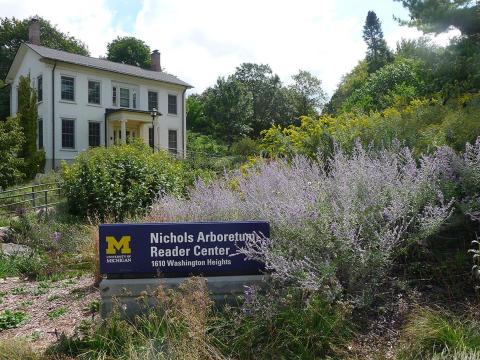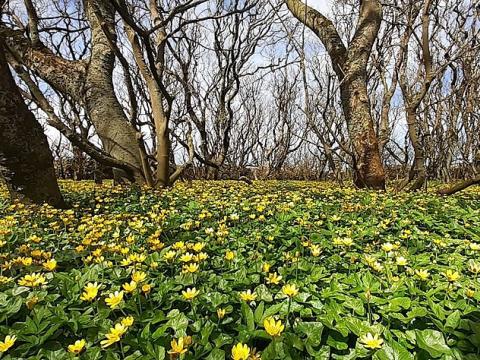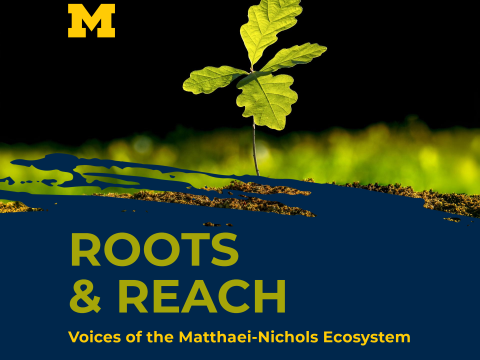This semester, a student-curated Black Nature Walk will wind through Nichols Arboretum in the trails around the Peony Garden. Titled "Earth Song," referencing a poem by Langston Hughes, the exhibit showcases nature poems by eleven Black authors, laser engraved onto wood panels. These panels are interspersed along the trails, with a final panel at the council ring, a circle of stones at the northeast corner of the gardens. A QR code on the welcome panel leads to the exhibit website, where you can listen to the students read the poems.
The walk has been thoughtfully curated by students enrolled in a course taught by Professor Bénédicte Boisseron in the Department of Afroamerican and African Studies (DAAS). The class is a section of the AAS 498 - DAAS In Action theme course titled Black Ecologies: Race and Nature. The introduction to the exhibit provides the definition of Black ecology as "the study of Black people in relation to their environment."
Tiffany Harris, one of the student curators, expands on this definition, making clear Black ecology is not simply about wild natural spaces. "Black ecology is the study of Black people in relation to the environment around us. This can be in relation to nature and urban environments as well."
In 2022, Joshua Bennett, a renowned poet, author, and professor, curated a multi-modal exhibit at the New York Botanical Garden featuring work by Black poets. The exhibit included similar displays of poetry on engraved wooden panels. The exhibit was titled "The Bond of Live Things Everywhere," referencing Lucille Clifton's poem "cutting greens." Inspired by this work, the student-curated experience of Earth Song will draw parallels in Nichols Arboretum.
The students have taken great care in choosing these poems, working collaboratively to curate a collection that balances grief and struggle with celebrations of joy and awe for the natural world. The exhibit highlights poems from Camille T. Dungy's 2009 anthology "Black Nature," the first published collection of nature writing by Black poets. The students added one more poem in light of the loss of Marcellus Williams, who was executed in Missouri on Tuesday, September 24th, 2024. His poem "At last… Another's heartbeat" is the culminating panel in the exhibit. As the curators state in their introduction to the exhibit, "Our selection of poems comes with a wide variety of interpretations and themes, including slavery, racism, capitalism, discrimination, oppression, but also beauty and joy. We invite you to offer your own interpretation."
The placement of Earth Song in the arboretum is appropriate, given the throughline of ecology and the natural world. However, as the first panel of the exhibit makes known, Earth Song is also a remembrance in a space shaped by the unseen influence of Black labor on the land. An oft-forgotten history of the arboretum is that some of its nature trails were the creation of segregated Works Progress Administration crews. In the 1930s, African American men labored to make the beloved nature paths and walking trails that still take visitors through the space. As the introduction panel states, "This walk honors the ancestors who came before us, as we seek to shine a light on the history hidden behind every tree and bush."
Chidimma Udegbunam, one of the student creators, has felt a personal impact working on this exhibit, and has hopes for what Earth Song might mean for its visitors."Working on this exhibit has shown me a lot of things. I have begun to question my own relationship with nature and the reasons why I avoid being outdoors. I have so many preconceived notions about who should and shouldn't be outside, and I've realized that there are historical and sociocultural contexts that explain why. It was (and still isn't always) safe for Black people to exist in nature. There are also hardly any representations of Black people in nature. When you don't see yourself in a setting, you often avoid the setting, which creates a never-ending cycle. My hope with this project is for people of color, Black people especially, to have a space to reflect like I have had the chance to do. I want people to re-examine their relationship with nature. I hope the nature walk can serve as a nail in the wheel, something to stop the cycle."
Tiffany Harris has similar hopes. "I hope our Black Nature Walk can make people start thinking about the ways in which our systems of discrimination and oppression have made Black people feel unsafe in the outdoors. I hope it makes people think about the ways that they can make Black people feel comfortable to be their authentic selves in the outdoors. I hope our Black Nature Walk motivates people to read more Black authors and learn more about Black Ecology. Lastly, I hope our Black Nature Walk provides a sense of safety and a place for deep reflection about how we can change our relationship to the outdoors."
Another student, Shao-Chi Ou, reflected on what the exhibit might prompt visitors to think about. "I think our exhibition is a good way to ask the visitors to think of a future where being in nature does not necessarily have to be a political statement, particularly for people of color."
In the words of Dr. Boisseron “Together, in our own Arboretum at the University of Michigan, we curated a walk through the trees, all the way to the clearing. We named it Earth Song, in honor of Langston Hughes. Now, my wish is that this walk never ends, that someone, somewhere, at some point, takes the baton and marches on.”





